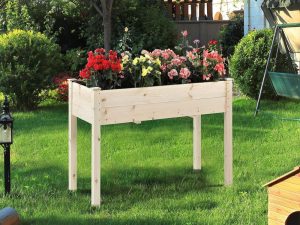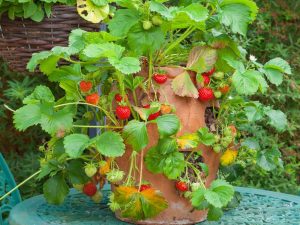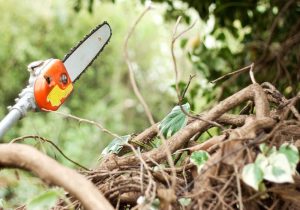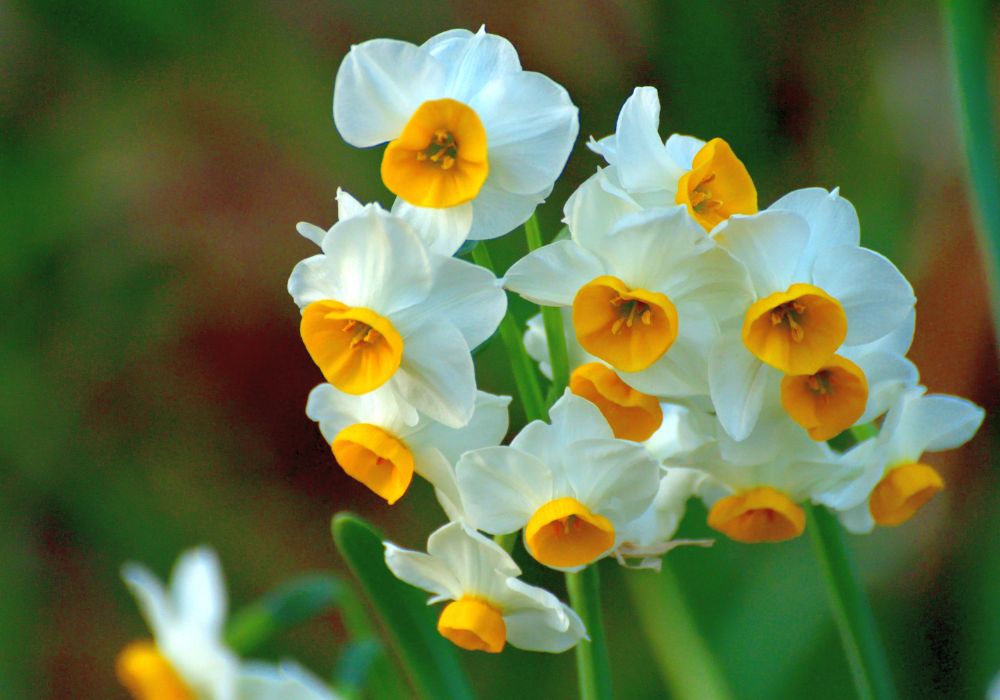
In casual conversation, the names “narcissus” and “daffodil” are often used synonymously, which fuels a common belief that they refer to different flowers. Actually, these words are linked in an interesting way that captures cultural preferences as well as botanical classification. The complex link between the narcissus flower and the daffodil will be discussed in this article together with their botanical similarities, variations in common use, and special qualities that define each name in different settings.
Botanical Background
Belonging to the Amaryllidaceae family, the narcissus flower is a genus of mostly spring-perennial plants distinguished by great beauty and fortitude. Commonly referred to under the umbrella term “narcissus flower,” this genus comprises a great range of species, officially known as the group including all forms of what are generally called daffodils.
In botany, the narcissus bloom is distinguished by its unusual form, usually including a central bell-shaped corona surrounded by a ring of petals. This defining characteristic distinguishes the narcissus flower in the plant kingdom and helps to explain its unique look that is honored in gardens all around.
Further diversifying the genus, the narcissus flower exists in several species and hybrids with rather different sizes, colors, and blooming patterns. Gardeners and botanists use the term “narcissus flower” to refer to variants that might not fit the popular image of the daffodil, which is only one species within the genus. This more general division clarifies the great variety present in this group.
The narcissus flower’s inclusive groupings underline its importance in horticulture and botanical research. Understanding the several species and cultivars in the genus helps aficionados and professionals value the richness and diversity the narcissus flower offers to gardens and landscapes worldwide.

Cultural and Historical Significance
The narcissus flower has a rich tapestry of historical and cultural relevance spanning millennia and continents. Respected and symbolically loaded, the story of the narcissus flower threads across ancient myths, art, and seasonal customs, highlighting its influence on many societies throughout history.
Ancient Roots and Mythology
Greek mythology is firmly anchored in the name “narcissus.” Legend has it that Narcissus was a young man of great beauty who fell in love with his own reflection in a pool of water and finally developed into the bloom bearing his name. As the narcissus bloom at the end of winter heralding the arrival of spring, this narrative has imbued the flower with symbolic meanings of both self-love and vanity as well as of rebirth and renewal.
Symbolism in Art and Literature
The narcissus flower has been a common subject in art and literature over centuries, representing a spectrum of ideas from death and vanity to rebirth and fresh starts. While in Wales it is a national emblem worn on St. David’s Day, in Victorian England the daffodil, another name for the most identifiable species of narcissus, became a symbol of unmet love. Poetry has repeatedly featured the flower as a symbol of endurance and hope since its connection with the end of winter and the arrival of spring defines it.
Cultural Celebrations and Traditions
Many societies place great respect for the narcissus flower in seasonal celebrations and customs. For example, Chinese society celebrates the blossoming of the narcissus flower during the Lunar New Year since it is thought to bring wealth and good fortune. In the same vein, the daffodil is central to the Nowruz, Persian New Year celebrations since it represents rebirth and a new beginning.
The narcissus flower’s great symbolic and aesthetic relevance is shown by its continuing appeal over many centuries and societies. From the perspective of mythology, artistic technique, or cultural festival customs, the narcissus flower still inspires and enthralls people all around.
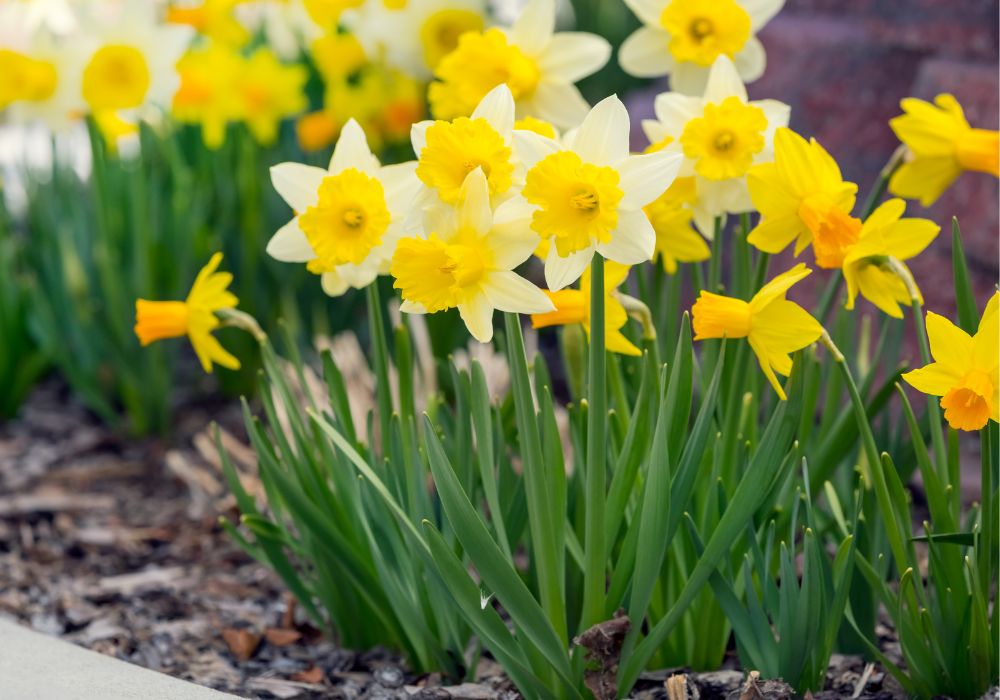
Morphological Differences
The narcissus flower exhibits a wide range of morphological variations that distinguish different species and cultivars within the genus. These differences not only highlight the diversity within the group but also help gardeners and enthusiasts identify and categorize the various types of narcissus flowers.
General Characteristics
Typically, the narcissus flower features a central corona or “trumpet” that is surrounded by six petal-like tepals. This structure is consistent across the genus. However, the size, shape, and color of the corona and tepals can vary dramatically among species. For example, in some narcissus flower varieties, the corona is long and tubular, while in others, it is short and bowl-shaped.
Daffodils vs. Other Narcissus Varieties
The term “daffodil” generally refers to those narcissus flower varieties with larger, trumpet-shaped coronas, bright yellow colors, and a bold, upright posture. These are contrastingly different from other narcissus flowers like the paperwhite, which is known for its cluster of small, white, fragrant flowers. Such distinctions are crucial for both botanical classification and aesthetic appreciation.
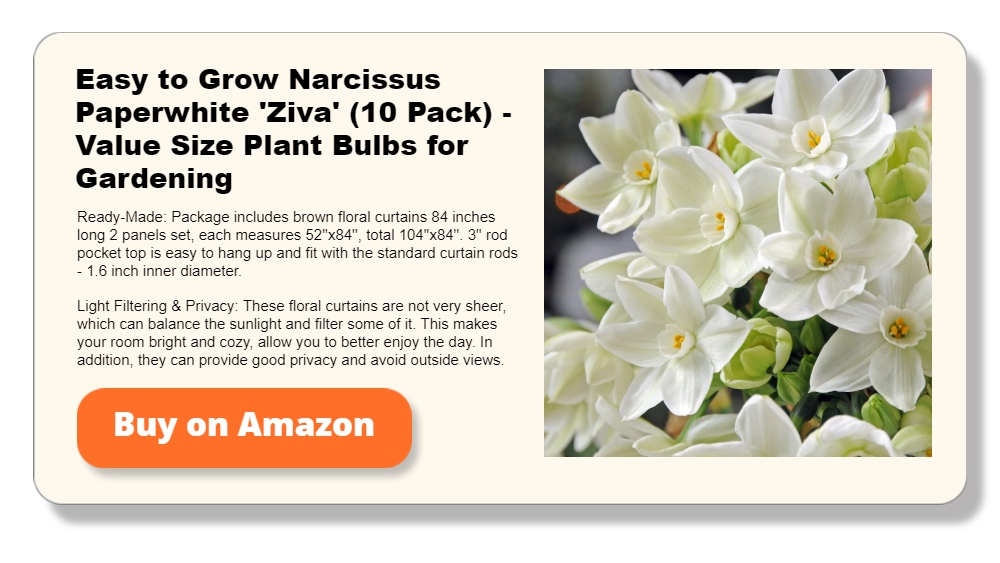
The Role of Jonquils
Within the narcissus family, jonquils are another distinct group, characterized by their rounded, reed-like leaves and clusters of small, fragrant flowers. Though they are part of the larger narcissus flower classification, jonquils have specific traits that set them apart, including their multiple flowers per stem and a generally more delicate appearance compared to the robust daffodils.
Varietal Diversity
The incredible variety within the narcissus genus means that morphological traits can be a blend of features, with some narcissus showing intermediate characteristics between well-known types like daffodils and jonquils. This diversity not only challenges simple categorization but also enhances the horticultural and ornamental value of the narcissus flower in gardens and landscapes across the globe.
By understanding these morphological differences, enthusiasts can better appreciate the complexity and beauty of the narcissus , making more informed choices about their gardening and landscaping projects.
Gardening and Care
Successfully cultivating narcissus flowers involves understanding their specific growing needs and environmental preferences. This section will provide practical advice and insights for gardeners looking to add these vibrant and diverse flowers to their gardens, ensuring healthy growth and stunning blooms season after season.

Choosing the Right Variety
Selecting the appropriate narcissus variety for your garden hinges on understanding the local climate and soil conditions, as well as your aesthetic preferences. Narcissus flowers come in a multitude of species and cultivars, each with unique characteristics and care requirements.
- Climate Considerations: Some narcissus varieties, like the robust daffodils, are well-suited to colder climates where they can endure the chill of early spring. Others, such as paperwhites, prefer milder winters and may thrive better in warmer regions.
- Soil Preferences: While most narcissus flowers are quite adaptable, they generally prefer well-drained, slightly acidic to neutral soil. Before planting, it’s beneficial to test your soil’s pH and amend it if necessary to meet these conditions.
- Aesthetic Choices: The visual appeal of narcissus flowers varies widely—from the classic yellow daffodil to the elegant white blooms of the paperwhite and the charmingly small cupped jonquils. Choose a variety that complements your garden’s design and color scheme.
Understanding these factors will help ensure that you select narcissus varieties that not only grow well in your environment but also meet your gardening goals and aesthetic desires.
Planting Techniques
Proper planting is crucial for the health and success of narcissus flowers. Following the right techniques can ensure vigorous growth and beautiful blooms.
- Timing: The best time to plant narcissus bulbs is in the fall, about two to four weeks before the ground freezes. This timing allows the bulbs to establish roots before the winter.
- Depth and Spacing: Generally, narcissus bulbs should be planted at a depth three times the height of the bulb. For most bulbs, this means planting them about 6 inches deep with about 3 to 6 inches between each bulb. This spacing helps prevent overcrowding and promotes adequate air circulation.
- Planting in Groups: For a striking display, plant narcissus bulbs in groups of 10 or more. This method creates a fuller, more natural look as opposed to scattering single bulbs throughout your garden.
- Orientation: Place the bulbs with the pointy end up and the root plate down. This orientation is essential as it helps the bulb orient itself correctly and start rooting more quickly.
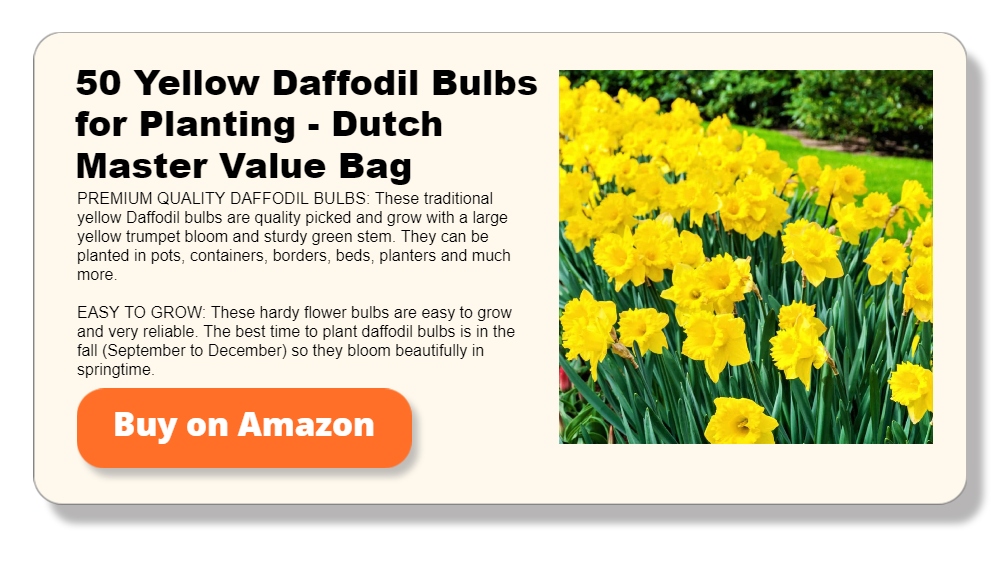
By adhering to these planting guidelines, you can maximize your narcissus plants’ potential for growth and ensure they become a vibrant part of your spring garden.
Soil and Sunlight Needs
Narcissus flowers need soil that fits their growth patterns and enough sunlight to bloom exquisitely if they are to flourish.
- Soil Preparation: Before planting, mix in organic compost or well-rotted manure to improve drainage and nutrient content on the garden bed. Because they rot easily in waterlogged conditions, Narcissus likes well-drained soil. For narcissus, the perfect soil pH falls between 6.0 and 7.0 or a somewhat acidic to neutral condition.
- Sunlight Requirements: Narcissus bloom best in partial shade to full sun. Strong growth and best blooming are advised from minimum six hours of direct sunlight. If you are growing in a particularly hot environment, think about a location with light afternoon shade to guard the plants from strong heat.
Proper soil preparation and ensuring adequate sunlight are key steps in creating a thriving environment for narcissus flowers, helping them to develop strong roots and abundant blooms.
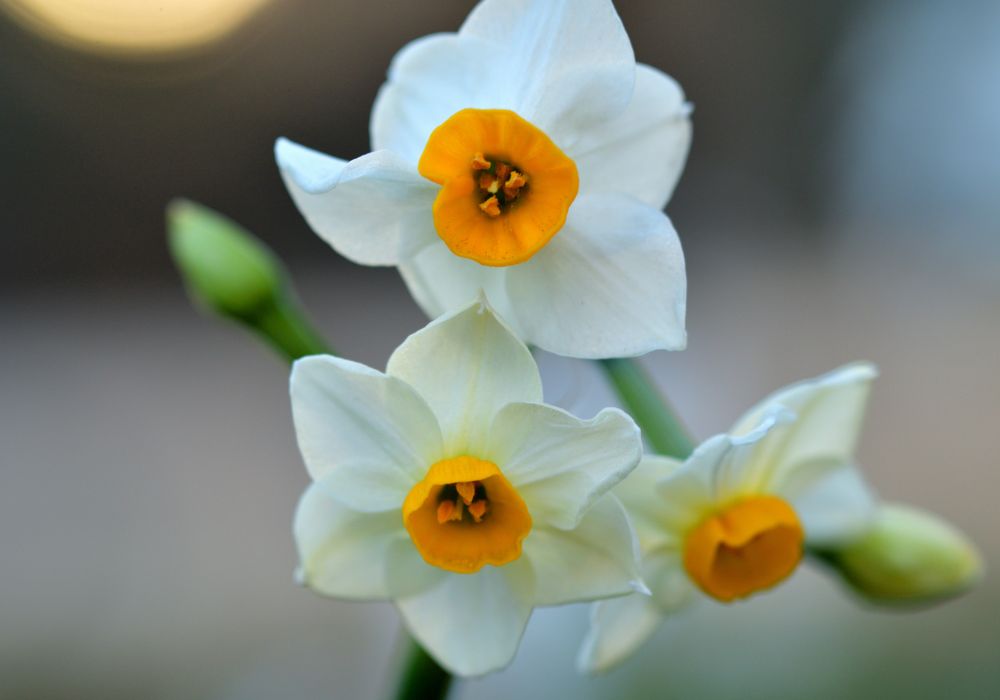
Watering and Fertilization
Consistent watering and timely fertilization are essential to maintain healthy narcissus plants.
- Watering Guidelines: While narcissus bulbs are drought-tolerant, they do require regular watering during the growing season, especially in the absence of rainfall. The soil should be kept moist but not soggy. Water the plants deeply once a week to encourage deep root growth, adjusting frequency depending on weather conditions and soil type.
- Fertilization Practices: Apply a balanced, slow-release bulb fertilizer at planting time to provide essential nutrients throughout the growing season. Another option is to use a high-potassium fertilizer when the shoots begin to emerge, which will help promote blooming. Avoid high-nitrogen fertilizers as they can encourage leaf growth at the expense of flowers.
Following these watering and fertilization strategies will support the vitality and longevity of your narcissus flowers, ensuring they remain a delightful feature in your garden each spring.
Pest and Disease Management
Keeping narcissus flowers healthy involves proactive pest and disease management. Understanding the common threats and how to combat them can help preserve the beauty and vitality of these plants.
- Common Pests: Aphids, bulb mites, and narcissus bulb flies are frequent pests that can damage narcissus plants. Aphids can be managed by rinsing them off with a strong stream of water or using insecticidal soaps. For bulb mites and flies, it’s essential to practice good sanitation by removing debris and spent foliage from around the plants.
- Disease Control: Narcissus is susceptible to several diseases, including basal rot, leaf scorch, and various fungal infections. Basal rot is a significant concern and can be mitigated by ensuring good drainage and avoiding overwatering. Fungal diseases often respond well to fungicides, but preventing overcrowding and ensuring adequate air circulation are also crucial preventive measures.
- Regular Monitoring: Regularly inspecting your narcissus plants for signs of distress, such as discolored leaves or stunted growth, can help you catch and address problems early before they spread.
Effective pest and disease management not only protects the narcissus plants but also ensures their environment remains conducive to healthy growth and beautiful blooms.

Post-Bloom Care
Proper care after the narcissus flowers have bloomed is crucial for ensuring their return in subsequent seasons. Here’s how to care for your narcissus plants once they’ve finished flowering:
- Deadheading: Remove spent flower heads to prevent the plants from spending energy on seed production. This helps direct the plant’s resources towards bulb strengthening for the next year.
- Foliage Care: Do not cut back the foliage until it has yellowed and died back naturally. The leaves produce food through photosynthesis, which is stored in the bulbs for next year’s growth.
- Bulb Division: Every 3 to 5 years, consider dividing your narcissus bulbs to prevent overcrowding and to rejuvenate older clusters. This is best done in the fall when the bulbs are dormant.
- Feeding: After blooming, apply a low-nitrogen, high-potassium fertilizer to help the bulbs store energy for the next season.
By following these post-bloom care tips, you can help your narcissus flowers remain robust and vibrant, ensuring a spectacular display for years to come.
Uses in Floriculture and Design
Narcissus flowers, with their striking blooms and variety of forms, play a versatile role in both floriculture and landscape design. Their ability to adapt to various settings and styles makes them a favorite among gardeners and floral designers. This section explores the various ways narcissus flowers can be incorporated into garden designs and floral arrangements, enhancing aesthetic appeal and bringing vibrant color to any space.
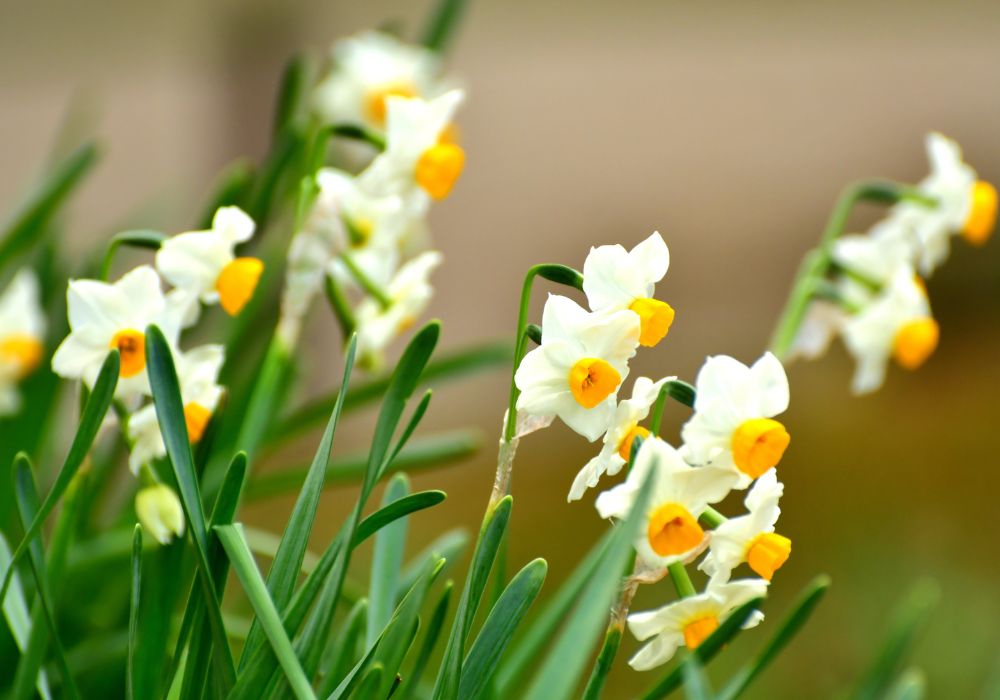
Impact in Garden Design
Narcissus flowers are excellent for adding bright splashes of color to garden beds, borders, and naturalized woodland areas. Their early bloom time helps bridge the gap between winter and spring, providing an early source of nectar for pollinators.
- Mass Plantings: Planting narcissus bulbs in large groups or drifts can create an impressive visual impact. This technique is particularly effective in large gardens or parks, where they can be seen from a distance, creating a sea of color that catches the eye and draws visitors into the space.
- Mixed Borders: Narcissus can be combined with other spring bulbs like tulips and hyacinths to extend the blooming season. They also pair well with early perennials and shrubs, providing a multi-layered display that evolves as the season progresses.
- Container Gardening: For those with limited space, narcissus flowers thrive in containers and can be used to brighten patios, balconies, or doorsteps. They can be mixed with other plants or displayed alone for a concentrated burst of spring color.
Role in Floral Arrangements
Not only are Narcissus flowers beautiful garden accents, but they also fit very nicely in floral arrangements. Whether included in classic bouquets or more modern designs, their unusual forms and sweet scent help them to stand out.
- Bouquets and Centerpieces: Springtime bouquets and centerpieces would find the vivid, joyful blossoms of narcissus ideal. They can be combined with other seasonal flowers or used alone to produce visually striking and fragrant arrangements.
- Wedding Florals: Narcissus flowers are a moving choice for wedding floral designs because of their symbolic of fresh starts and actual love. From table settings to bridal bouquets, they can be included into everything to provide the unique day some natural beauty and a little elegance.
- Thematic Designs: Special events or themed gatherings allow narcissus to be used to express particular ideas or emotions. A white narcissus display, for example, might represent simplicity and purity—qualities perfect for ceremonies or polite gatherings.
Educational and Therapeutic Uses
Beyond their aesthetic and aromatic appeal, narcissus blossoms find use in therapeutic and educational contexts, so supporting environmental education and horticultural therapy.
- Educational Programs: Gardens, including varieties of narcissus, can be used as living classrooms where guests and students can study plant biology, ecology, and the value of diversity.
- Horticultural Therapy: Planting and caring for narcissus bulbs can be simple chores with therapeutic value in horticultural therapy. Working with these flowers is common in horticultural therapy programs to help with mental and physical wellness, encourage leisure and a sense of accomplishment.
More than just beauty, Narcissus blooms provide for gardens and floral designs—a range of useful and aesthetic advantage. Any horticultural project would benefit from their adaptability in floriculture and capacity to improve both private and public areas. Gardeners and designers can maximize their impact and enjoy their vivid colors and pleasant smells all year long by knowing the several uses these flowers can offer.
Conclusion
Although all daffodils are technically narcissus flowers, not all narcissus varieties are daffodils. There is still a large difference between narcissus and daffodils. Even experienced gardeners confuse the two at times. While “narcissus” covers a wider spectrum of species with varied forms and colors, the term “daffodil” is frequently used to refer to the familiar, trumpet-shaped varieties that are synonymous with spring. Knowing these variations improves respect of the diversity of the genus and guides better gardening techniques.



